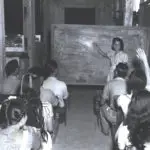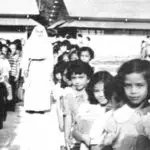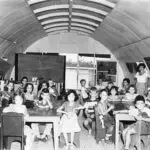Education After WWII



Table of Contents
Share This
Before and after the war
Following World War II, the people of Guam faced not only the looming reconstruction of community structures and homes, but also institutional and cultural change. For Guam’s children some of the most significant transformations affected their daily lives — specifically, what and where students would learn, and who taught them at school.
Pre-war schooling: A brief history
With a military presence that was small in the newly acquired territory, the US Naval administration nonetheless needed a labor force that possessed a basic command of English and would present no health threats to its personnel. Additionally, the administration wanted CHamorus/Chamorros to be less Spanish-like and more American. In 1951 a Naval administrator wrote that the CHamorus needed instruction because they were a:
“listless, ambitionless, unorganized mass of humanity stirred only by the hope for individual survival.”
Thus, schools emphasized secular education in American-oriented “training for life.” School administrators pushed a curriculum consisting of rudimentary American English, agricultural and vocational training, as well as lessons on American citizenship, geography and civics. A public health program enforced school-based inspections of hands, teeth, and clothes and provided mandatory treatments for such parasites as hook-worms.
Many US Naval Era teachers were only a few years older than their pupils as Guam students were only required to have completed eighth grade. They taught by recitation and drilling. Few eligible children (those age 7-12) actually attended school. School grades went to 8th grade, but affluent CHamorus and those passing a specific test could continue on to secondary school. School grades also were not differentiated by age; a 4th grade class, for example, might include students from the ages of 9-12. Finally, military and civilian populations were largely educated in different facilities.
Buildings, location, and supplies
The first schools after World War II were established in wood frame buildings or repurposed quonset huts. The first concrete school was built in 1948 in the southern village of Agat. Without sufficient funds, laborers, and the space to accommodate all students, however, many of these temporary structures remained until 1962 when Typhoon Karen destroyed them. Only after that major typhoon did the civilian government of Guam begin to construct more permanent buildings, starting with elementary schools, with emergency funding from the US federal government.
Where students went to school also changed after the war. Before the war, Guam’s population lived primarily in the capital of Hagåtña or in small southern villages. Hagåtña residents usually also had an outlying låncho (ranch) lands. Prior to the war, the Navy wanted to discourage people from living in the capital city, instead preferring that CHamorus focus on agricultural efforts on their låncho. The Navy even gave school attendance exemptions to students they deemed to live too far from the Hagåtña schools.
Post-war reconstruction, however, allowed the Navy to implement these agricultural plans to an even greater extent. With Hagåtña leveled, the Navy dispersed the town population to several new locations. These newly populated areas became the villages of Agat, Sånta Rita-Sumai, Barrigada, Sinajana, Agana Heights, Dededo, and Yigo. Schools were established to serve the children in these areas.
Immediately after the war, students resumed classes—bringing crates to sit on and studying mimeographed lessons that teachers had run off from magazines. The military gave used and/or surplus science equipment and supplies to schools.
Teachers
Following the war, expanding enrollments of both military dependent and CHamoru civilian populations created a need to recruit and hire more teachers. The government sought to expand teacher rolls by hiring off-island contract instructors, employing dependents of military personnel, and using local student teachers. Additionally, individual teacher qualifications were expanded, paving the way to full-scale professionalization of educators.
During the first half of pre-war Guam, teachers were generally sailors, Marines, military wives and off-island contractors. Later local residents became teachers too. Students went to school compulsorily until age twelve, and thereafter could seek high school or Normal School (teacher) training, competitively. Most teachers began instructing when they were 15 or 16-years-old. In 1939 at least 55 percent of teachers had less than 10 years of teaching experience.
This trend of using young student teachers continued briefly after the war, although the Normal School was discontinued and the Territorial College (today’s University of Guam) was instituted in 1952 to train local teachers more extensively. Under Governor Carlton Skinner’s first director of education, Jose Palomo, the Territorial College used staff from Ohio State University to professionally train teachers.
Additionally, in 1948 the Guam Congress asked the governor to set aside ten percent of local revenue to support local CHamoru teachers to train at overseas universities; this funding was denied because the governor did not feel the government was responsible for providing leadership development. Subsequently, after the Organic Act, local legislators put together loan and grant programs targeting local youth to pursue college.
Student teachers were also utilized to address the teacher shortages. These student teachers were high school students who would attend one session of the two-session school day, and then teach during the other session. They were assigned to the middle grades since it was often assumed that the best and most qualified teachers belonged in the elementary grades.
Off-island contract teachers
Once more children and families of military personnel arrived on island, the Navy wanted to accommodate these students to American-standard schooling with its certified, college-educated instructors. Since Naval policy had historically restricted secondary and higher education of CHamorus, a local pool of college-trained teachers was not immediately available. The post-war administration thus began a twofold program to build the teacher corps: first, to hire military dependents (such as officers’ wives) as teachers, and second, to offer contract positions for off-islanders, offering jobs with relocation and living stipends as incentive for moving to Guam. These contract teachers were predominantly placed in schools with higher percentages of military dependents and almost exclusively at the secondary school, George Washington High School.
Working on contracts that lasted one to two years, these temporary teachers lived in special living quarters and received up to a 25 percent higher wage than locally hired teachers. A Naval report issued in 1948, for example, found that a one-year contract teacher earned $3,718, a locally hired US resident would make $2,975, and an island resident earned $2,360. This kind of pay disparity continued throughout the civil government with contract teachers and was called the territorial pay differential, or TPD. The TPD was discontinued in 1964 due in part to a government concern about the policy’s effects on teacher corps morale.
Because of the contract teaching programs, CHamoru children began to interact on a more regular basis with Americans. School became not only a place of instruction in reading and writing, but also that of off-island teachers.
Demographic changes
In 1940, Guam’s teachers numbered 166, and out of those, about 96 percent of them were CHamoru. Just after the war in 1947, Guam’s teachers numbered 212, 190 of which were off-island hires. The numbers of Guam-born teachers began to rise, however, and in 1951 there were 305 teachers, 99 of whom were CHamoru.
Lessons
Immediately following the war, the main priorities of the military government in implementing a reconstructed school system included building enough facilities and hiring personnel. It had a stated objective of offering a system comparable to that if stateside systems, with a long-term vision of cultivating people with higher education for island leadership.
School lessons in the elementary school included health (in the form of drills and calisthenics), English, math, and geography. Within the secondary school, George Washington offered four tracks: college preparatory, commercial, vocational, and general education. Vocational education was offered because of ongoing labor shortages; students would then take jobs outside of school and/or take limited vocational-education supplemental instruction at the College of Guam for non-credit.
Policy changes
Several educational policies would have far-reaching effects on the future Guam population and its culture. Some of these policies, such as the English language policies of speaking English only at school, were extensions of pre-war educational objectives and philosophies, while others, such as compulsory universal high school, were entirely new.
Desegregation
Prior to the war, there were several types of educational opportunities in Guam: homeschooling with a tutor (usually for the CHamoru elite), private religious schools, public schools, the Guam Institute, and American School. The latter served dependents of military personnel, while the Guam Institute was a comprehensive private primary and secondary school up to twelfth grade attended by more affluent CHamorus.
Due to limited numbers of military dependents on island after the war, the Naval administration discontinued the segregated school systems. Subsequently dependents attended Guam public schools and paid a fee to do so; military families would pay $5 per child attending a village school per month, and $4.10 to attend a school with a high military enrollment like Adelup.
However, despite the formal policy of not designating specific schools for military dependents exclusively, schools were established in areas that resulted in high populations of military dependents. Additionally, the cheaper rate of attending these schools encouraged military families to choose these schools.
One of the first elementary schools established was at Adelup near Nimitz Hill and later became associated with military dependents. Another school was established at Hila’an once Andersen Air Force Base in the north expanded. Local children could attend these schools but they were mostly populated with military dependents.
Compulsory universal education
Changes in the island’s economy after the war, due to the increase of the size and scope of the US military’s presence in Guam, demanded a more educated workforce. The Naval administration thus instituted compulsory universal school attendance until age 16, an increase of four years from the mandatory age of 12 prior to the war. The Board of Education, headed by civilians, also recommended compulsory education attendance for children ages seven to 16.
English language policies
The Navy’s need to have a larger English-speaking civil service workforce led to the push for limitations and restrictions on speaking the CHamoru language. Policies to achieve this were put in place with the arrival of the first Naval governor and reinstated after the war. Naval and school administrators encouraged parents to speak English at home and students who spoke CHamoru at school were ticketed or fined for infractions.
It bears mentioning that although the curricula emphasized English usage and instruction and “no CHamoru” rules were implemented, it was necessary to use CHamoru to supplement English instruction. This was practiced more in primary-grade classrooms as a matter of practicality since CHamoru was the predominant language still spoken in Guam homes.
In 1900, Guam’s first appointed Naval Governor Richard P. Leary issued General Order No. 12 relative to public school education. Among other things it stated:
“Instruction in the English language will be introduced in the public schools as soon as suitable teachers can be provided, and it is expected that the present force of native teachers will cheerfully and harmoniously cooperate with the teachers of English in order that the greatest benefits may be derived by both scholars and preceptors.”
To continue with the frame of thought of the day, General Order No. 13 was enacted, which stated:
“All residents are recommended to utilize every available opportunity to learn how to read, write, and speak the English language, thereby improving their own mental condition as well as preparing themselves for assisting their children who are required by law to attend school.”
These language policies were in place during pre-war Guam and only interrupted with the invasion of Japanese enemy forces in December 1941. After the retaking of the island by the Americans in July 1944 and the rebuilding of Guam and commencement of school, the policies continued.
A typical day
A primary school student would walk to the local village school—either a wood frame building or quonset hut—to be there by 7:30 in the morning. For a female student, she would greet teachers and other staffers, usually CHamoru employees from her village. Joining classmates, she would begin the day with some morning exercises, including stretching and singing the Guam Hymn.
For the next three to four hours, the teacher would instruct the children in academic subjects like English, reading and writing, arithmetic, and geography. Textbooks were imported from the US and included popular readers such as Fun with Dick and Jane.
Next, this student would join other female classmates to learn about sewing or cooking. Around noon, she would either eat a meal she brought to school with her, or go home and eat lunch. In the afternoon, she might leave to do chores for the family while her brother attended school with the village’s other male children. He in turn would learn the lessons she had covered earlier that morning, with the exception that his non-academic hours would be filled with instructions on farming or manual labor.
A typical George Washington High School student interacted with contract teachers, who might encourage him to pursue college. He could attend classes related to one of the four tracks offered: college preparatory, vocational, general education, and commercial. He met at least a few stateside or military dependent high school students; although he probably wouldn’t be able to sustain a long-term friendship—as military dependents would move later on—he would at least learn a little bit more about them. Finally he might have a part-time paying job in addition to his responsibilities on the family låncho ranch.
On track with growth and change
By 1950, the student population within the public school system numbered 8,802, with a little more than 100 students attending Catholic high schools (Father Duenas for boys and Academy of Our Lady for girls) that had been established two years prior. The majority of public school students were 1st through 6th graders enrolled in elementary school numbering 6,286 students, and 2,516 more students in grades seventh through twelfth. These numbers were a significant increase from the 7,537 enrolled in 1946.
Additionally, the demographics of the student body were beginning to change as a result of a CHamoru baby boom and the establishment of a larger, more permanent military presence. Between the years 1950-1960, CHamoru enrollments would increase by more than forty percent, military dependent enrollments by eight percent, Filipino enrollments by over 200 percent, and “Other” enrollments (which would include groups from islands part of the present-day Commonwealth of Northern Marianas and the Federated States of Micronesia) by forty percent.
It is also important to note that although there was a huge influx in percentage changes for Filipino and CNMI/FSM (Commonwealth of the Northern Mariana Islands/Federated States of Micronesia) enrollees, they comprised altogether less than five percent of the total school population.
For further reading
Albert, Francis Lee. “History of the Department of Education in Guam During the American Administration.” Guam Recorder 8, no. 7 (1931): 373, 378-386.
Althouse, Adelbert. Letter to the Secretary of the Navy, April 28, 1923. Naval Government Collection. Micronesian Area Research Center, University of Guam.
Johnson, Robert G. “Recommendation on the Administration of the Schools of Guam in Light of the Island Culture.” EdD diss., Florida State College, 1959.
Mansfield, C. “Education: An observation.” Guam Recorder, (March 1937).
Underwood, Robert A. “American Education and the Acculturation of the Chamorros of Guam.” EdD diss., University of Southern California, 1987.
US Naval Government of Guam. Quarterly Reports. Hagåtña: Naval Government of Guam, 1946-1949.
US Navy Department. Advisory Committee on Education for Guam and the Trust Territory of the Pacific Islands. Honolulu: NoD, 1949.
US Office of the Chief of Naval Operations. US Navy Report on Guam, 1899-1950. Washington, DC: OPNAV, 1951.
